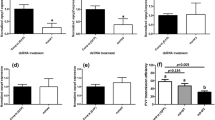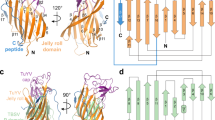Abstract
A fraction of the coat protein (CP) subunits in virions of members of the family Luteoviridae contain a C-terminal extension called the readthrough domain (RTD). The RTD is necessary for persistent aphid transmission, but its role is unknown. It has been reported to be required for virion stability in the hemolymph. Here, we tested whether this was the case for pea enation mosaic virus (PEMV) virions in the pea aphid (Acyrthosiphon pisum) using RNA1Δ, a natural deletion mutant lacking the middle portion of the RTD ORF, and CPΔRTD, in which the entire RTD ORF was deleted. In infected plants, RNA1Δ virions were as abundant and stable as wild-type (WT) virions, while CPΔRTD virions were unstable. No RTD of any size was translated from artificial subgenomic mRNA of CPΔRTD or RNA1Δ in vitro. Thus, only the major CP was present in the mutant virions. Using real-time RT-PCR to detect virion RNA, no significant differences in the concentration or stability of WT and RNA1Δ virions were detected in the aphid hemolymph at much longer times than are necessary for virus transmission. Thus, the RTD is not necessary for stability of PEMV RNA in the aphid hemolymph, and it must play another role in aphid transmission.







Similar content being viewed by others
References
Brault V, Van den Heuvel JF, Verbeek M, Ziegler-Graff V, Reutenauer A, Herrbach E, Garaud JC, Guilley H, Richards K, Jonard G (1995) Aphid transmission of beet western yellows luteovirus requires the minor capsid read-through protein P74. EMBO J 14:650–659
Brault V, Perigon S, Reinbold C, Erdinger M, Scheidecker D, Herrbach E, Richards K, Ziegler-Graff V (2005) The polerovirus minor capsid protein determines vector specificity and intestinal tropism in the aphid. J Virol 79:9685–9693
Brault V, Herrbach E, Reinbold C (2007) Electron microscopy studies on luteovirid transmission by aphids. Micron 38:302–312
Brown CM, Dinesh-Kumar SP, Miller WA (1996) Local and distant sequences are required for efficient readthrough of the barley yellow dwarf virus PAV coat protein gene stop codon. J Virol 70:5884–5892
Bruyere A, Brault V, Ziegler-Graff V, Simonis M-T, van den Heuvel JF, Richards K, Guilley H, Jonard G, Herrbach E (1997) Effects of mutations in the beet western yellows virus readthrough protein on its expression and packaging and on virus accumulation, symptoms and aphid transmission. Virology 230:323–334
Chay CA, Gunasinge UB, Dinesh-Kumar SP, Miller WA, Gray SM (1996) Aphid transmission and systemic plant infection determinants of barley yellow dwarf luteovirus-PAV are contained in the coat protein readthrough domain and 17-kDa protein, respectively. Virology 219:57–65
de Zoeten GA, Skaf JS (2001) Pea enation mosaic and the vagaries of a plant virus. In: Advances in virus research. Academic Press, New York, pp 323–350
Demler SA, de Zoeten GA (1989) Characterization of a satellite RNA associated with pea enation mosaic virus. J Gen Virol 70:1075–1084
Demler SA, Zoeten GA (1991) The nucleotide sequence and luteovirus-like nature of RNA 1 of an aphid non-transmissible strain of pea enation mosaic virus. J Gen Virol 72:1819–1834
Demler SA, Borkhsenious ON, Rucker DG, de Zoeten GA (1994) Assessment of the autonomy of replicative and structural functions encoded by the luteo-phase of pea enation mosaic virus. J Gen Virol 75:997–1007
Demler SA, Rucker-Feeney DG, Skaf JS, de Zoeten GA (1997) Expression and suppression of circulative aphid transmission in pea enation mosaic virus. J Gen Virol 78:511–523
Dinesh-Kumar SP, Brault V, Miller WA (1992) Precise mapping and in vitro translation of a trifunctional subgenomic RNA of barley yellow dwarf virus. Virology 187:711–722
Fauquet CM, Mayo MA, Maniloff J, Desselberger U, Ball LA (2005) In: 8th Report of the International Committee on Taxonomy of Viruses. Academic Press, Elsevier
Filichkin SA, Brumfield S, Filichkin TP, Young MJ (1997) In vitro interactions of the aphid endosymbiotic SymL chaperonin with barley yellow dwarf virus. J Virol 71:569–577
Gildow FE (1993) Evidence for receptor-mediated endocytosis regulating luteovirus acquisition by aphids. Phytopathol 83:270–277
Gildow FE (1999) Luteovirus transmission mechanisms regulating vector specificity. In: Smith HG, Barker H (eds) The Luteoviridae. CABI, Wallingford, pp 88–111
Gildow FE, Reavy B, Mayo MA, Duncan GH, Woodford JAT, Lamb JW, Hay RT (2000) Aphid acquisition and cellular transport of Potato leafroll virus-like particles lacking P5 Readthrough protein. Phytopathol 90:1153–1161
Goncalves MC, van der Wilk F, Dullemans AM, Verbeek M, Vega J, van den Heuvel JFJM (2005) Aphid transmission and Buchnera sp. GroEL affinity of a potato leafroll virus RTD deficient mutant. Fitopatol bras 30:259–266
Gray SM, Banerjee N (1999) Mechanisms of arthropod transmission of plant and animal viruses. Microbiol Mol Biol Rev 63:128–148
Gray SM, Gildow FE (2003) Luteovirus-aphid interactions. Annu Rev Phytopathol 41:539–566
Harris KF (1979) Leafhoppers and aphids as biological vectors: vector-virus relationship. In: Maramorosch K, Harris KF (eds) Leafhopper vectors and plant disease agents. Academic Press, New York, pp 217–308
Lai S-C, Chen C-C, Hou RF (2001) Electron microscopic observations on wound-healing in larvae of the mosquito Armigeres subalbatus (diptera: Culicidae). J Med Entomol 38:836–843
Lee L, Palukaitis P, Gray SM (2002) Host-dependent requirement for the Potato leafroll virus 17-kDa protein in virus movement. Mol Plant-Microbe Interact 15:1086–1094
Leiser RM, Ziegler GV, Reutenauer A, Herrbach E, Lemaire O, Guilley H, Richards K, Jonard G (1992) Agroinfection as an alternative to insects for infecting plants with beet western yellows luteovirus. Proc Natl Acad Sci USA 89:9136–9140
Liu S, He X, Park G, Josefsson C, Perry KL (2002) A conserved capsid protein surface domain of cucumber mosaic virus is essential for aphid vector transmission. J Virol 76:9756–9762
Liu S, Bonning BC, Allen Miller W (2006) A simple wax-embedding method for isolation of aphid hemolymph for detection of luteoviruses in the hemocoel. J Virol Meth 132:174–180
Markus R, Kurucz R, Rus F, Ando I (2005) Sterile wounding is a minimal and sufficient trigger for a cellular immune response in Drosophila melanogaster. Immunol Lett 101:108–111
Miller WA, Liu S, Beckett R (2002) Barley yellow dwarf virus: Luteoviridae or Tombusviridae? Mol Plant Path 3:177–183
Mohan BR, Dinesh-Kumar SP, Miller WA (1995) Genes and cis-acting sequences involved in replication of barley yellow dwarf virus-PAV RNA. Virol 212:186–195
Mutterer JD, Stussi-Garaud C, Michler P, Richards KE, Jonard G, Ziegler-Graff V (1999) Role of the beet western yellows virus readthrough protein in virus movement in Nicotiana clevelandii. J Gen Virol 80:2771–2778
Nurkiyanova KM, Ryabov EV, Commandeur U, Duncan GH, Canto T, Gray SM, Mayo MA, Taliansky ME (2000) Tagging potato leafroll virus with the jellyfish green fluorescent protein gene. J Gen Virol 81:617–626
Nurkiyanova KM, Ryabov EV, Kalinina NO, Fan Y, Andreev I, Fitzgerald AG, Palukaitis P, Taliansky M (2001) Umbravirus-encoded movement protein induces tubule formation on the surface of protoplasts and binds RNA incompletely and non-cooperatively. J Gen Virol 82:2579–2588
Peter KA, Liang D, Palukaitis P, Gray SM (2008) Small deletions in the potato leafroll virus readthrough protein affect particle morphology, aphid transmission, virus movement and accumulation. J Gen Virol 89:2037–2045
Prüfer D, Wipf-Scheibel C, Richards K, Guilley H, Lecoq H, Jonard G (1995) Synthesis of a full-length infectious cDNA clone of cucurbit aphid-borne yellows virus and its use in gene exchange experiments with structural proteins from other luteoviruses. Virology 214:150–158
Reavy B, Mayo MA (2002) Persistent transmission of luteoviruses by aphids. Adv Bot Res 36:21–46
Reichhart JM (2005) Tip of another iceberg: Drosophila serpins. Trends in Cell Biol 15:659–665
Reinbold C, Gildow FE, Herrbach E, Ziegler-Graff V, Goncalves MC, van den Heuvel JF, Brault V (2001) Studies on the role of the minor capsid protein in transport of Beet western yellows virus through Myzus persicae. J Gen Virol 82:1995–2007
Rochow WF (1970) Barley yellow dwarf virus: Phenotypic mixing and vector specificity. Science 167:875–878
Rouze-Jouan J, Terradot L, Pasquer F, Tanguy S, Giblot Ducray-Bourdin D (2001) The passage of Potato leafroll virus through Myzus persicae gut membrane regulates transmission efficiency. J Gen Virol 82:17–23
Ryabov EV, Robinson DJ, Taliansky M (2001) Umbravirus-encoded proteins both stabilize heterologous viral RNA and mediate its systemic movement in some plant species. Virology 288:391–400
Salgueiro S, Hull R (1999) Comparison of pea enation mosaic virus (PEMV) isolates: sequence of coat protein and aphid transmission protein genes of a European isolate. J Phytopathol 147:391–396
Skaf JS, Rucker DG, Demler SA, Wobus CE, de Zoeten GA (1997) The coat protein is dispensable for the establishment of systemic infections by pea enation mosaic enamovirus. Mol Plant-Microbe Interact 10:929–932
Skaf J, Schultz M, Hirata H, de Zoeten G (2000) Mutational evidence that the VPg is involved in the replication and not the movement of Pea enation mosaic virus-1. J Gen Virol 81:1103–1109
Taliansky M, Mayo MA, Barker H (2003) Potato leafroll virus: a classic pathogen shows some new tricks. Mol Plant Pathol 4:81–89
van den Heuvel JF, Verbeek M, van der Wilk F (1994) Endosymbiotic bacteria associated with circulative transmission of potato leafroll virus by Myzus persicae. J Gen Virol 75:2559–2565
van den Heuvel JFJM, Bruyere A, Hougenhout SA, Ziegler-Graff V, Brault V, Verbeek M, van der Wilk F, Richards K (1997) The N-terminal region of the luteovirus readthrough domain determines virus binding to Buchnera GroEL and is essential for virus persistence in the aphid. J Virol 71:7258–7265
Veidt I, Bouzoubaa SE, Leiser RM, Ziegler-Graff V, Guilley H, Richards K, Jonard G (1992) Synthesis of full-length transcripts of beet western yellows virus RNA: messenger properties and biological activity in protoplasts. Virology 186:192–200
Acknowledgments
The authors thank the late Dr. Gus A. de Zoeten for generously providing the infectious clones of the PEMV genome, and Dr. Robert L. Harrison for making the anti-PEMV antiserum. This work was funded by the USDA North Central Biotechnology Program 97-34340-39087 to BCB and WAM, and USDA grant number 2005-35607-15233 to WAM and BCB. This journal paper of the Iowa Agriculture and Home Economics Experiment Station, Ames, Iowa, Project No. 6651, was supported by Hatch Act and State of Iowa funds.
Author information
Authors and Affiliations
Corresponding author
Rights and permissions
About this article
Cite this article
Liu, S., Sivakumar, S., Wang, Z. et al. The readthrough domain of pea enation mosaic virus coat protein is not essential for virus stability in the hemolymph of the pea aphid. Arch Virol 154, 469–479 (2009). https://doi.org/10.1007/s00705-009-0327-7
Received:
Accepted:
Published:
Issue Date:
DOI: https://doi.org/10.1007/s00705-009-0327-7




